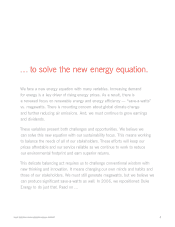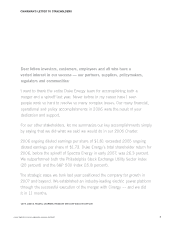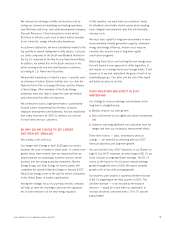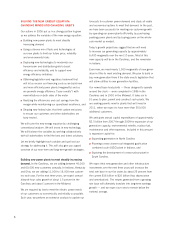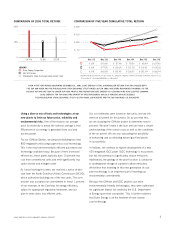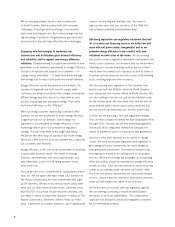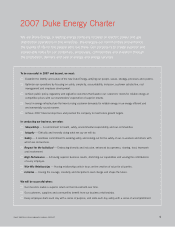Duke Energy 2006 Annual Report Download - page 8
Download and view the complete annual report
Please find page 8 of the 2006 Duke Energy annual report below. You can navigate through the pages in the report by either clicking on the pages listed below, or by using the keyword search tool below to find specific information within the annual report.6
SOLVING THE NEW ENERGY EQUATION:
CHANGING MINDS AND CHANGING HABITS
Our actions in 2006 put us in a strong position to grow
as we address the variables of the new energy equation:
Building new power plants to meet steadily
increasing demand
Using a diverse mix of fuels and technologies at
our new plants to limit our future price, reliability
and environmental risks
Deploying new technologies to modernize our
transmission and distribution grids to boost
efficiency and reliability, and to support new
energy efficiency initiatives
Obtaining legislation and regulatory treatment that
will let us recover our financing costs as we build new
and more efficient power plants (megawatts) and as
we promote energy efficiency (“save-a-watts”) with
new initiatives on both sides of the meter
Realizing the efficiencies and cost savings from the
merger while maintaining our operational excellence, and
Shaping new federal rules that limit carbon emissions
to ensure our customers and other stakeholders are
fairly treated.
We will solve the new energy equation by challenging
conventional wisdom. We will invest in new technology.
We will balance the variables by working collaboratively
with all stakeholders to find the best and fairest solutions.
Let me briefly highlight each variable and spell out our
strategy for addressing it. This will also give you a good
overview of our near-term and long-term growth strategies.
Building new power plants to meet steadily increasing
demand. In the Carolinas, we are adding between 40,000
and 60,000 new customers annually. In Indiana, Kentucky
and Ohio, we are adding 11,000 to 16,000 new custom-
ers each year. For the next three years, we expect annual
kilowatt-hour sales growth of about 1.5 percent in the
Carolinas and about 1 percent in the Midwest.
We are required by law to meet the electric power needs
of our customers as economically and reliably as possible.
Each year, we perform an extensive analysis to update our
■
■
■
■
■
■
forecasts for customer power demand and study all viable
and economical options to meet that demand. In the past,
we have been successful in meeting our customer growth
by operating our power plants efficiently, by purchasing
peaking power plants and by buying power on the whole-
sale market as needed.
Today’s growth projections suggest that we will need
to increase our generating capacity by approximately
6,400 megawatts over the next 10 years. Most of this
new capacity will be in the Carolinas, and the remainder
in Indiana.
Even now, we need nearly 1,500 megawatts of new gener-
ation in Ohio to meet existing demand. We plan to build or
buy new generation there if the state enacts legislation that
will allow utilities to own generation facilities.
Our newest base load plants — those designed to operate
around the clock — were completed in 1986 in the
Carolinas and in 1991 in the Midwest. It takes six to
10 years to plan, permit and construct such plants. We
are seeking permits now for plants that we’ll need in
2011, when we expect to have more than 250,000
additional customers.
We anticipate annual capital expenditures of approximately
$3.5 billion from 2007 through 2009 for expansion of our
generation capacity, environmental retrofits, nuclear fuel,
maintenance and other expenses. Included in this amount
is expansion capital for:
Expanding generation in North Carolina
Planning a new cleaner-coal integrated gasification
combined cycle (IGCC) plant in Indiana, and
Exploring the development of a new nuclear plant in
South Carolina.
We expect that new generation and other infrastructure
investments over the next three years will increase the
total rate base in our five states by about 25 percent from
the current $16 billion to $20 billion (less depreciation
and amortization). The returns generated from a growing
rate base will ultimately translate into long-term earnings
growth — and we expect our rates to remain below the
national average.
■
■
■



